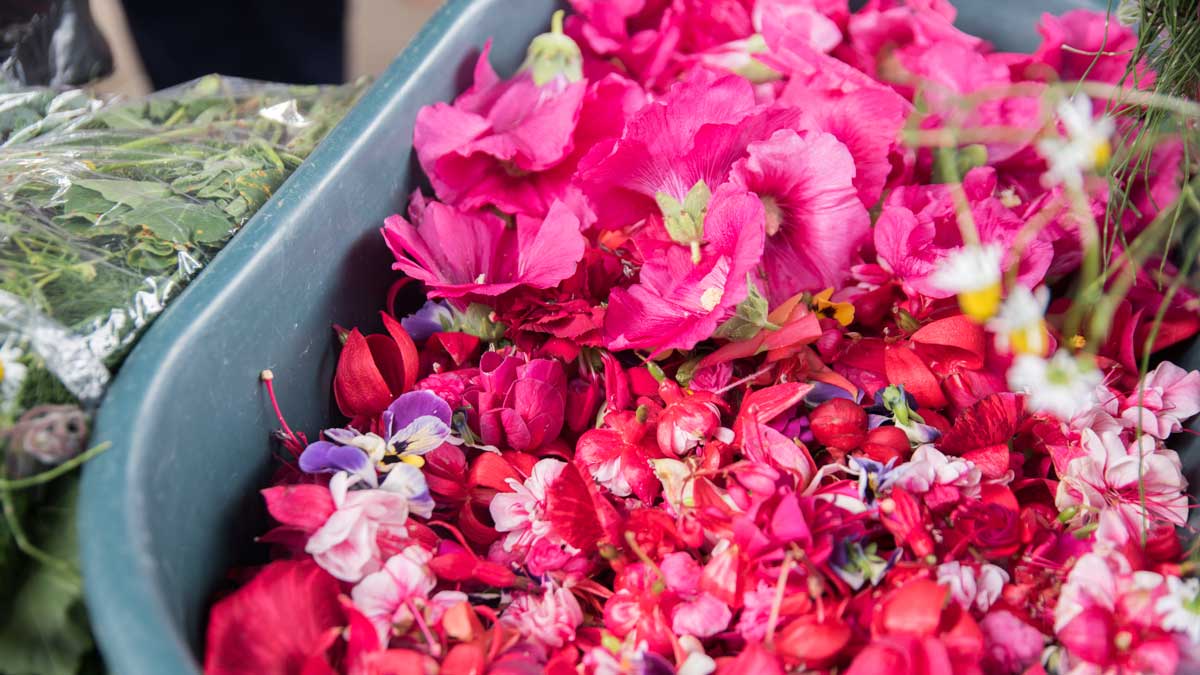We had already tried several versions of horchata before I realized that this drink is unique to Southern Ecuador, especially in the Loja Province. I learned about it when visiting the small Saraguro market with my friend, Luz. It was mid-morning and we were after a warm pick-me-up. She took to a popular market booth where a friend served drinks kept warm in large, metal pots. With a deep ladle, Luz’s friend served up to steaming cups of non-caffeinated, fuchsia-colored tea, slightly sweetened with panela, a lightly processed brown sugar. She then offered us slices of lime. We squeezed the lime juice into each of our mugs, inhaled the citrusy, floral scent, and then drank deeply. The tea warmed me to the bottom of my toes, a good thing on a cold, damp, Saraguro morning.
What is Horchata?
Since that time, I have had horchata many times. I began to notice that the supermarkets sold packets of dried flowers and herbs so that I could make my own horchata at home. However, nothing beats the fresh flowers and herbs sold at markets throughout Loja. It made me wonder exactly what ingredients are the most important. As you might expect, every woman has her own recipe but almost all of them use the following ingredients:
- Ataco or Sangorache (Amaranthus hybridus L.) – Purple or Black Amaranth
- Cedrón (Aloysia citrodora) – Lemon Verbena (sometimes confused with Lemon Grass)
- Hierba Luisa (Cymbopogon citratus) – Lemon Grass
- Toronjil or Melisa (Melissa officinalis)- Lemon Balm
- Manzanilla – Chamomile; there are several common species
- Escancel (Aerva sanguinolenta) – no English translation
- Congona (Peperomia inaequalifolia) – Radiator Plant
- Borraja (Borago officinalis) – Borrage
- Shullo (Oenothera Rosea) – Evening Primrose
- Colla de Caballo – Horsetail; there are several species
While visiting a small town near Cuenca called San Bartolomé, we tried a type of horchata that also included rose geranium and azaleas. I have seen other recipes that include hierba buena and other types of mint. At the end of the day, if a plant grows in a small village garden, it’s probably found its way into a version of horchata.
The plants can be dried and infused in hot water to make tea. Or they can be used fresh.
Why Is It Called Horchata?
The Spanish word horchata comes from the Latin hordeata which mean a drink or food made of grain. In Mexico, horchata is a drink made of rice, a type of grain. It is creamy white, spiced with cinnamon, and almost always served over ice. In Ecuador, a necessary ingredient for horchata is amaranth, usually the leaves and flowers rather than the grain itself. However, the name of the drink likely came about when Spanish colonists saw indigenous Ecuadorians making a drink by infusing the grain amaranth.
The Health Benefits of Horchata
Ecuadorians believe that horchata is anti-inflammatory and helps reduce stress. It’s also claimed to improve digestion, clear the mind, and cure cancer. The Health Sciences Department of the Technical University of Loja studied the health affects of ten different teas purchased in a variety of markets in Loja. They had a particular interest in testing the teas on cancer cells. After preparing various tisanes, they found that five prevented new growth of the cancerous cells. The study has yet to be replicated.
Other health benefits of drinking horchata include providing your body with vitamins and minerals. This is especially important in a culture that eschews eating green vegetables.
Where to Find Horchata
The most common place to find horchata is any small, family run restaurant. The drink of choice offered with a set-lunch menu is luke-warm or room temperature horchata, pre-sweetened and flavored with either lemon or lime. Sometimes, we ask market vendors to fill our metal flasks with tea to warm us on a cold, mountain hike.
However, my favorite place to try horchata was in San Bartolomé, home of guitar makers and Doña Elmira. On our visit to her home, Doña Elmira collected aromatic herbs and colorful flowers from her own garden, steeped them in hot water, and served our small party of four a delicious version of horchata. The best part, she served the beautiful tea in clear glass cups so that we could enjoy its stunning hue. Amazingly, we learned that the dash of lime juice not only adds flavor but turns each gorgeous pink tea into a deep, dark purple red, a chemical change that doesn’t appear in the metal or ceramic mugs of the market.
If you would like to buy horchata to take back to the United States, look for packets in the tea aisle or order from Amazon. They will be large bags full of dried flowers. One bag makes a couple of liters of tea, so buy several. Or start a horchata garden at home and brew it fresh!

















0 comentarios